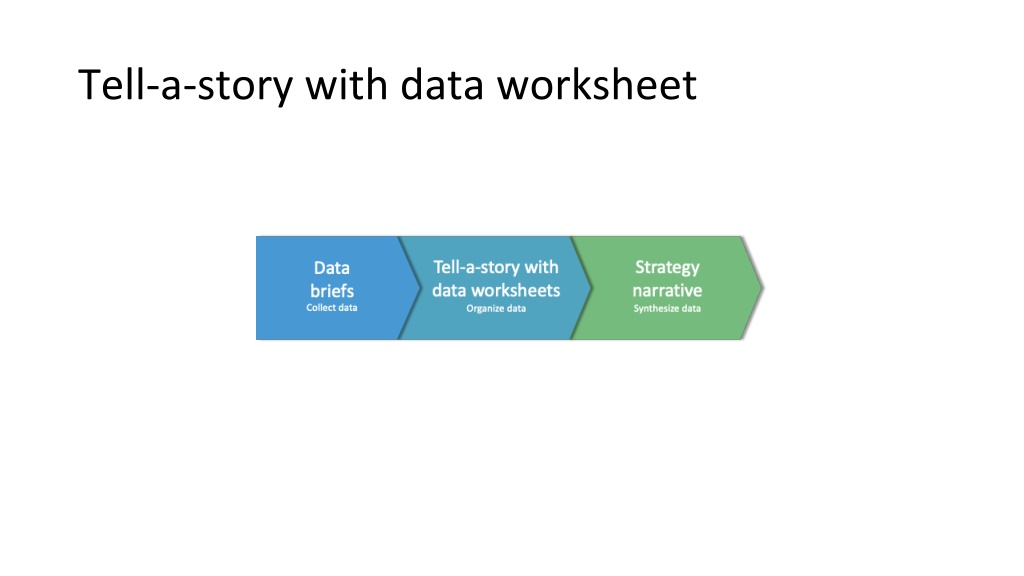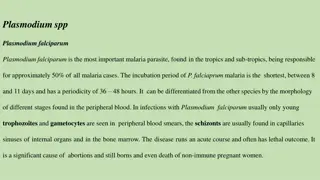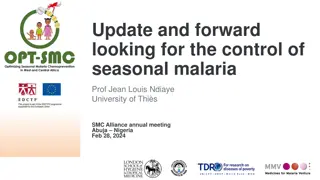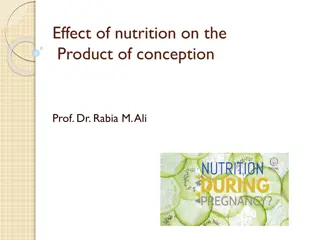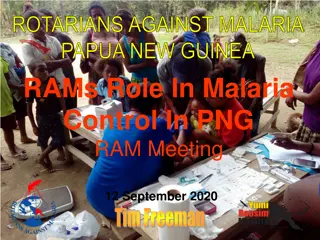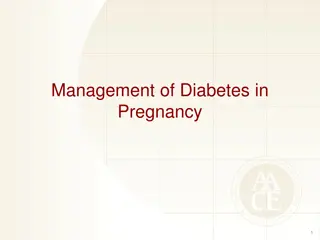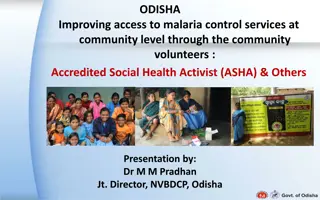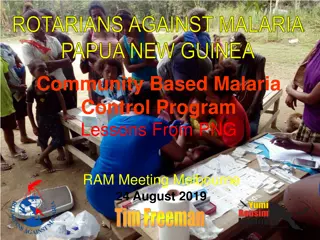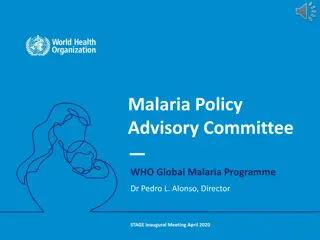Malaria in Pregnancy Attitudes & Behaviors
Data on attitudes, efficacy, norms, exposure, and behaviors related to malaria in pregnancy. Understand the factors influencing community behaviors and access to knowledge. Gain insights into the situation and behavioral analysis for effective strategies.
Download Presentation

Please find below an Image/Link to download the presentation.
The content on the website is provided AS IS for your information and personal use only. It may not be sold, licensed, or shared on other websites without obtaining consent from the author. Download presentation by click this link. If you encounter any issues during the download, it is possible that the publisher has removed the file from their server.
E N D
Presentation Transcript
Malaria in Pregnancy Attitudes, Efficacy, Norms Exposure Community Behaviors % who ever heard messages or information about .. Knowledge Access % of pregnant women who .. % who have correct knowledge about .. % who have access to .. % of pregnant women who .. Situation analysis and behavioral analysis: While access, exposure, knowledge, attitudes, efficacy, and norms will be described in the behavioral analysis, actual behaviors will be described in the situation analysis (use data from malaria in pregnancy data brief to complete the following slides)
Situation analysis Malaria SBC strategies should include a situation analysis for each intervention. These situation analyses should include quantitative and qualitative data that describes who is affected and how severely (to what extent) by which problems.
? ? ? ? Behavior % who practice behavior ? ? Situation analysis: use the malaria in pregnancy data brief (behaviors section) to fill in these boxes (add boxes as necessary). A narrative summary will be used to complete the strategy malaria in pregnancy situation analysis.
Summarize your data here in narrative form and paste it into the strategy template malaria in pregnancy situation analysis section Situation analysis:
Behavior analysis The description of the underlying drivers behind specific behaviors is articulated in a behavioral analysis. This analysis summarizes any data explaining why certain audiences or target groups choose to practice, or refuse to practice, healthy behaviors. As determinants of behavior may be structural, cognitive, social, or emotional, it is important to collect data to better understand what drives specific audiences to behave as they do. Each behavioural analysis should describe these determinants in context.
? ? ? ? Access ? ? Behavior analysis: use the malaria in pregnancy data brief to fill in these boxes (add boxes as necessary). A narrative summary of behavioral determinants will be used to complete the strategy malaria in pregnancy behavior analysis.
? ? % who saw or heard message in the last 6 months % exposed to each channel of communication Exposure ? ?
? ? ? ? Knowledge ? ?
? ? Positive attitudes ? ? ? ?
? ? ? ? Response efficacy ? ?
? ? ? ? Self efficacy ? ?
? ? Social norms ? ? ? ?
? ? ? ? Decision making ? ?
? ? ? ? ? ? ? ? ? Exposure % who heard or saw messages Access % with access to facility ? ? ? ? ?
? ? ? ? ? ? ? Social Norms Knowledge % who have correct knowledge Attitudes Efficacy ? ? ? ? ?
Example: Cte dIvoire Family & Friends 6.3% cited friends and relatives as source of malaria messages Distance 3% live greater than 15 km from health facility Radio 21.7% Attended Some ANC 85.5% attended at least 2 ANC visits cited radio as source of malaria messages TV Attended 65.8% cited TV as source of malaria messages Recommended ANC visits 75.6% attended 4+ ANC visits Exposure % who heard or saw messages Access % with access to ANC Print 5.9% Supplies Self-Efficacy 95.6% believe they can go to at least four ANC visits at health facility Health Worker 4.6% cited health workers as source of malaria messages Facilities have IPTp medicines in stock, as well as clean cups and drinking water cited billboards and posters as source of malaria messages
Example: Cte dIvoire Safety Attitudes ANC 78.4% know that a woman should attend at least four ANC visits Perceived Threat 93.4% of women believe malaria in pregnancy is very serious 91.3% women and 88.7% men believe IPTp medications are safe 56.6% women and 61.4% men have positive attitudes toward ANC / IPTp IPTp 22.6% know that a woman must receive three doses of IPT during pregnancy Maternal Health 96.3% women and 95.5% men believe IPTp is effective in keeping mothers healthy Knowledge % who have correct knowledge Attitudes Efficacy Social Norms Timing 80.9% Norms 70.0% believe using IPTp is the norm in their community Self-Efficacy 97.7% women believe they can take IPTp at least three times during pregnancy Health Provider Knowledge & Practice Health providers know and provide IPTp at ANC visits Prenatal Health 95.4% women and 95.8% men believe IPTp is effective in keeping babies healthy know that a woman should go for her first ANC visit in the first quarter or as soon as she knows she is pregnant
Early ANC attendance Provider Behaviors Attitudes, Efficacy, norms Supply Chain Exposure % of providers who.. Community Behaviors % who ever heard messages or information about .. Knowledge Access IPTp SUPPLY % of caregivers who .. % who have correct knowledge about .. % of all household members who .. % who have access to ANC % providers who.. % of caregivers who Additional considerations: where information about supply chain issues and/or availability or quality of service provision, or service provider behaviors and attitudes are available, it may be possible to add these data points to the situation and behavior analyses narratives.
Summarize your data here in narrative form and paste it into the strategy template malaria in pregnancy behavior analysis section Behavior analysis:
Audience analysis and strategic approaches An audience analysis should describe primary, secondary, and tertiary audience characteristics as they relate to each behaviour. Both socio-demographic (sex, age, language, etc.) and psycho-social characteristics (personality, attitudes, beliefs, values, emotions, etc.) should be described, as well as any available data on media consumption habits, message exposure, and message recall among specific sub-groups Strategic approaches should describe how to best reach and influence each audience. Following the socio-ecological model, use the audience analysis to specify how to reach and influence each audience at the structural, social, and individual level.
Audience analysis and strategic approaches Malaria in pregnancy audience analysis Audience analysis: Primary audience: Secondary audiences: Tertiary audiences: Strategic communication approaches: Primary audience: Secondary audiences: Tertiary audiences: (Where appropriate) Considerations for low, very low, and zero transmission:
Behavior-specific communication plans Each intervention-specific plan should contain behavior-specific communication plans, which address specific behavioural objectives. A behavioural objective articulates what behavior must change. Behavioural objectives measure a single behavior and specify the audience whose behavior is expected to change.
Malaria in pregnancy behavior no.1 [list here] Behavior objective [list here] Primary audience: Secondary audience:: Communication objective n 1 : Communication objective n 2 : Key benefit: Supporting points:
Malaria in pregnancy behavior no.1 [list here] Behavior objective [list here] Primary audience: Secondary audience: Communication objective n 1 : Communication objective n 2 : Key benefit: Supporting points:
Malaria in pregnancy behavior no.1 [list here] Behavior objective [list here] Primary audience: Secondary audience:: Communication objective n 1 : Communication objective n 2 : Key benefit: Supporting points:
